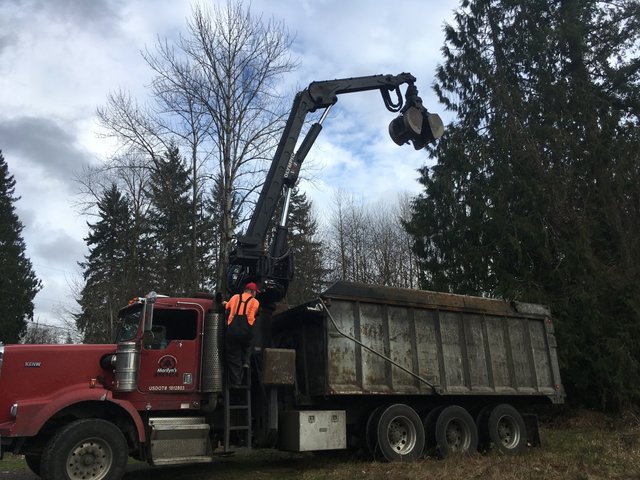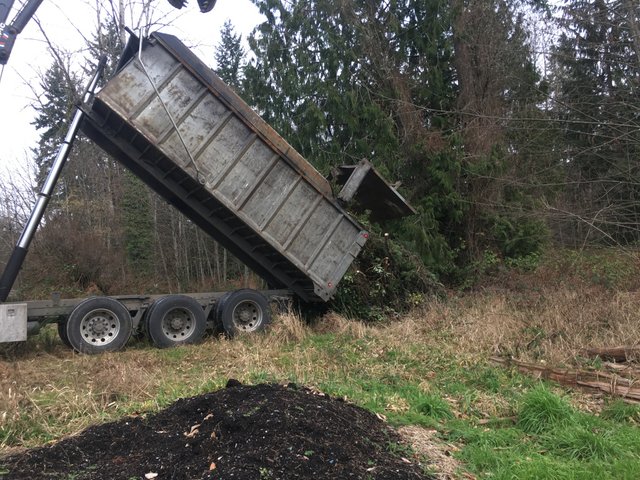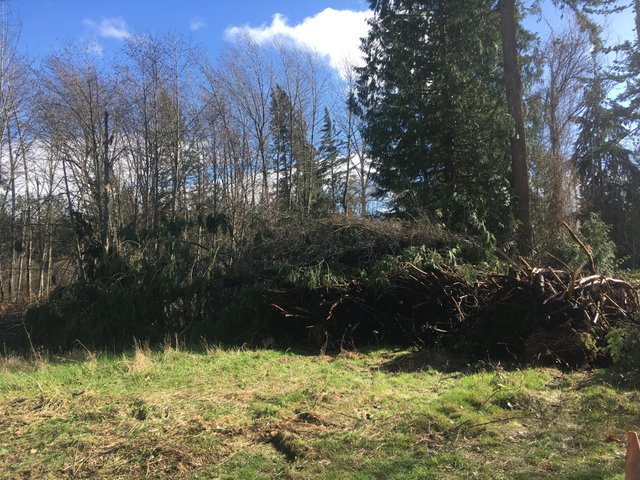Biodiversity & Renewal of Topsoil

Leafhopper Farm does not use a tractor, but sometimes, machines make light work. This truck brought several loads of biomass (brush and tree limbs) to the farm, staging them for a summer project in which we will place this organic material in our forest stands to cover eroded forest floor and encourage the renewal of topsoil and biodiversity.

It is always amazing to me that people need to get rid of biomass, and regularly send it to the dump or some other kind of land fill. It is also amazing to me that people chip large matter into smaller matter using a large amount of fuel and time to do something nature is quite good at on her own terms. But we like instant gratification, and the power over the natural world. Heck, I dug water features and plant all kinds of non-native species around the farm without hesitation. Humans love to manage nature.

This large mulch will fill in where the forests have fallen behind due to overgrazing. Without top soil, under-story vegetation cannot get a good foot hold. We’ll manipulate the environment by placing a concentration of biomass in the woods to act as a platform for mycelium. As the biomass breaks down, we’ll plant in under-story shrubs like mock orange and twin berry. We’ll introduce different strains of mycelium to encourage the mushroom decomposes of wood. In time, this brush will become black gold.
Moving all this material takes time, and machines, and people who operate those machines efficiently. We’re staging materials with one truck, hauling from location to drop point at the edge of my land where my neighbor is cool with me storing organic materials. Later this summer, we’ll have other trucks come to pick up the brush, moving it down to the forest on my land when the ground is solid for machines. We’ll also a few of the stands, milling the wood and piling branches on contour along the slope. Then we’ll bring in this stages biomass to fill in under the remaining trees in each stand.

The truck helps us gather measurable vegetation for a very large scale mulching extravaganza. I cannot imagine how many wheelbarrow loads and pickup truck runs it would take me to move something like this. Understanding scale is very important as you plan projects. Sometimes you’ll have trouble fully grasping what kind of scale you’re working with until a project begins in earnest.
I’ve been calculating how much clay it would take to seal our pond, and discovered it would take over 200 tons of material. That’s a lot of truck loads, not to mention the machines it would take to properly spread and pack down the clay around the pond. We’re going to try more spot sealing this summer, with only a few truckloads of clay and minimal machine work. I’m sensitive to when and where large machines come into the landscape, and thankful they are available to help shift our limitations, allowing fast setting of habitat for future restoration here at Leafhopper Farm.
Liz Crain
@leafhopperfarm

To learn more about Leafhopper Farm visit us at:
LeafhopperFarm.com, YouTube, Twitter & Minds
soil and ways in which we humans can actually promote and/or accelerate the production of it ourselves is an EXTREMELY fascinating and useful topic in my opinion! Currently, it is one of those areas of knowledge that are mystical and magical to me, and anyone I find who has even half a clue what they're doing with it, I hold in very high regard! Outstanding post, not just for its content, but for its inspiration as well!
The wife and I are currently shopping for our first true homestead of any size, and one of the areas we have available to us is what used to be known as "hard scrabble"...98% rocks, with a little bit of soil mixed in between. It occurred to me that MAYBE if we bought land like this (because it is far cheaper than land with real dirt!), MAYBE we could "make our own dirt" over several large areas. But because my current level of knowledge and experience doing something like that is so miniscule, I feel a little bit chicken about committing to such a project. What do you think...could you take a hard scrabble acre and turn it into a fertile piece of land with actual dirt on it in any reasonable amount of time? (maybe like, 2 years or less?)
Thanks for your feedback!
Great post about keeping the soil in top condition. I can’t believe how much you are bring in to heal your fields for maximum production.🐓🐓